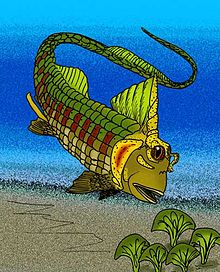This article has multiple issues. Please help improve it or discuss these issues on the talk page. (Learn how and when to remove these messages)
|
Campbellodus decipiens is an extinct ptyctodontid placoderm fish that lived around 380 million years ago (Late Devonian). Its fossil remains have been found preserved in perfect three-dimensional form from the Gogo Formation of Western Australia. Originally it was described from large tooth plates and isolated skull roof bones by Miles & Young (1977). Long (1995) restored the complete fish based on new material found at Gogo in the mid 1980s, and described by Long (1997).
| Campbellodus Temporal range: Late Frasnian
| |
|---|---|

| |
| Artist's reconstruction | |
| Scientific classification | |
| Domain: | Eukaryota |
| Kingdom: | Animalia |
| Phylum: | Chordata |
| Class: | †Placodermi |
| Order: | †Ptyctodontida |
| Family: | †Ptyctodontidae |
| Genus: | †Campbellodus Miles & Young, 1977 |
| Species: | †C. decipiens
|
| Binomial name | |
| †Campbellodus decipiens Miles & Young, 1977
| |
| Synonyms | |
| |
Campbellodus has very short spinal plates, and is unusual in having a high dorsal spine formed by three median dorsal plates. The tooth plates are very robust and the upper plate has a high anterior spine.
Sources
edit- Long, J.A. 1995. The Rise of Fishes - 500 Million Years of Evolution. Johns Hopkins University Press, Baltimore, 230pp.
- Long, J.A. 1997. Ptyctodontid fishes (Vertebrata, Placodermi) from the Late Devonian Gogo Formation, Western Australia, with a revision of the European genus Ctenurella Orvig, 1960. Geodiversitas 19(3): 515–555.
- Miles, R.S. & Young, G.C. 1977. Placoderm interrelationships reconsidered in the light of new ptyctodontids from Gogo, Western Australia. Linnean Society of London, Symposium Series 4: 123–198.